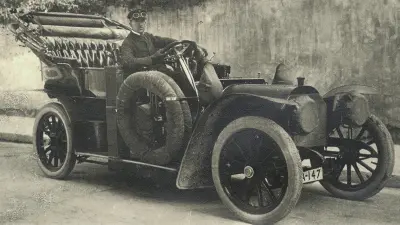Adventures in mobility with Bosch
From driving with a chauffeur to autonomous driving

Individual mobility has undergone constant change since the invention of the automobile. The history of the automobile began with chauffeurs driving car owners to their destination. Soon, “self-drivers” took the wheel. In the future, with autonomous driving, chauffeurs will make a return, albeit in virtual shape.
Mobility for advanced users
At the end of the 19th century, the German Kaiser Wilhelm II is said to have remarked: “I’ll stick with horses — the car is just a fad.” Automobility was still in its infancy, and the enormity of its significance frequently still had to be grasped. The few automobiles that did exist were the preserve of the wealthy who liked to go for a spin, albeit with a chauffeur.
For safety’s sake, people had a chauffeur do the driving for them. Chauffeurs kept an eye on the traffic and the horse-drawn carriages and other automobiles crossing their route. Moreover, they often doubled up as mechanics. This was useful in the event of breakdowns.

In the back seat or at the wheel?

However, when it came to selling cars, reliance on a chauffeur had a decisive disadvantage: “Global demand for motor vehicles will not exceed one million — not least because of the lack of available chauffeurs,” the car designer Gottlieb Daimler said in 1901. Over time, it became fashionable for car owners to take the wheel themselves. In doing so, they were following in the footsteps of the car pioneer Bertha Benz. In 1888, she herself had driven her three-wheeled Benz patent motorcar no. 3 from Mannheim to Pforzheim. And whether as a shopping trip or a country outing, the driving experience was something self-drivers took pleasure in. Anyone who was anyone soon owned an automobile. The car became a status symbol.
Trial with three-wheeler
For an entrepreneur like Robert Bosch, the new cars offered a new field of work for his electrical engineering portfolio. Bosch also wanted to make driving easier for self-drivers. By further developing the magneto ignition, he offered a reliable solution that allowed cars to cover longer distances. The initial trial of this magneto-electric ignition was carried out on a three-wheeler, a “Beeston Voiturette” made by the British company Humber. This was a British copy of the French De Dion-Bouton model.
The electric starter motor which Bosch premiered in 1914 was a significant milestone for self-drivers. Up to then, drivers had had to crank the engine to start their car. This carried the risk of potentially dangerous starter-crank kickback. Now, instead of being a dangerous procedure, starting was a routine operation, requiring no effort on the part of drivers. In the case of other developments as well, we can see how technology gradually relieved the burden on drivers.

Making life easier for the driver
In the early days of motoring, with its first mobility concepts, drivers still had to perform many tasks themselves that had very little to do with actual driving. This was not without risk, as these side activities took their attention away from the road, impairing road safety. Bosch came up with ways of relieving drivers of these tasks, thus improving safety. Two of them date from the 1920s: the windshield wiper and the direction indicator. Before the advent of electric windshield wipers, drivers wiped the windshield with their bare hands. A direction indicator, functionally a forerunner of today’s turn signal, was also introduced. This meant that drivers did not have to take their hands off the steering wheel to indicate which way they wanted to turn.

Electronic helpers

In later decades as well, car safety remained important at Bosch. In the 1970s, with traffic increasing and cars becoming faster, electronic assistants were added to the product range. Bosch debuted its antilock braking system in 1978. It made cars steerable even in slippery conditions and enabled controlled braking. This has since prevented countless fatal accidents. Dangerous driving situations were thus defused. This is also the case with ACC adaptive cruise control, an automatic distance radar system that Bosch added to its range in 2000. With this system, the car automatically adjusts the safety distance to the vehicle in front without the driver having to do anything. With the debut of ACC in the 21st century, Bosch took its first steps toward automated driving.
Automated and autonomous driving
In the future, a driver behind the wheel and manual steering may no longer be necessary. In autonomous driving, the aim is that the car drives itself, entirely without a driver. This will call for courageous steps. Safety demands mean that handing over control is a challenge. Residual technical risks and an uncertain legal situation with regard to issues such as liability still have to be clarified. However, autonomous driving also offers (fellow) drivers safety, convenience, and more free time. During journeys, it will be possible to use media and have relaxed conversations with other occupants — without putting others at risk.

A new chauffeur?
However, there is still a long way to go before autonomous vehicles become a common sight on our roads — cars that can get from A to B on any route completely without a driver, as if by magic. The chauffeur of tomorrow could be the car itself.
Author: Katja Bethge



